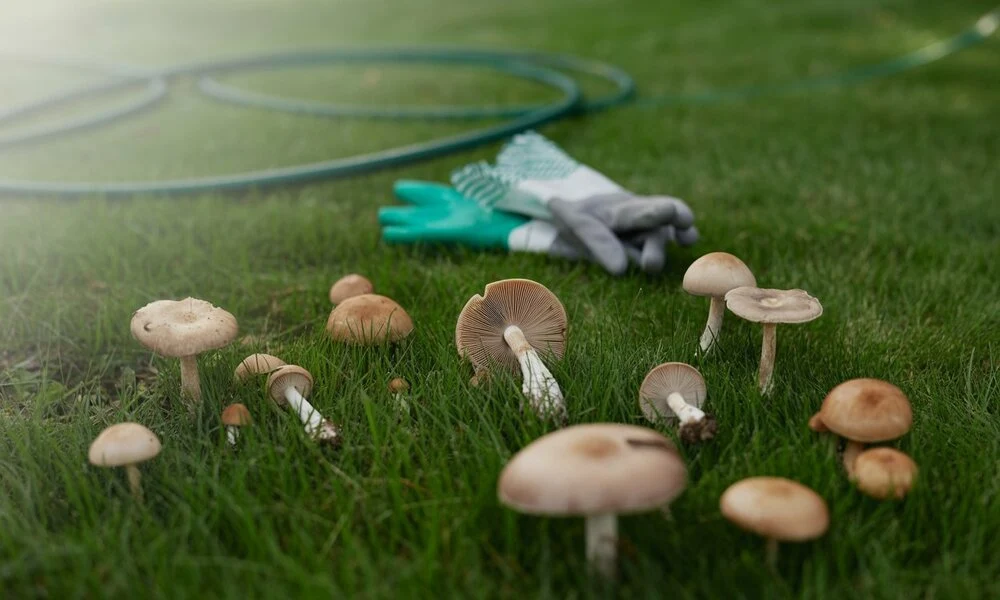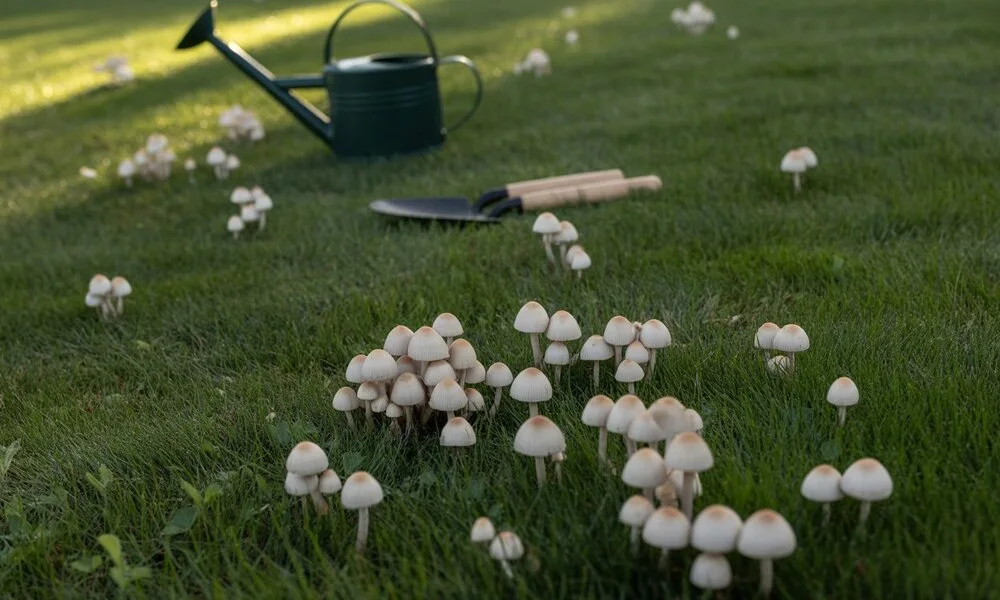How to get rid of mushrooms in lawn can be a common concern for homeowners, especially when these fungi begin to take over the grass. Mushroom growth in your lawn is often a sign of underlying moisture issues, decaying organic matter, or poor soil conditions. For those dealing with unsightly fungi, mushroom removal from lawn is essential not only for aesthetic reasons but also to maintain a healthy grass environment. Getting rid of mushrooms in grass can be done effectively through a combination of improving drainage, reducing excess moisture, and properly maintaining the lawn. By understanding the causes and implementing proper control methods, you can restore your lawn to its healthy, mushroom-free state.
Why Are There Mushrooms In My Lawn?

Mushrooms in your lawn are a natural part of the ecosystem, playing important roles in the environment. They act as decomposers, breaking down organic matter such as dead leaves, tree roots, and other plant debris. This process returns vital nutrients to the soil, enriching it for future plant growth.
Ideal Conditions for Mushroom Growth
Mushrooms thrive in specific conditions:
- Moisture: Mushrooms need a moist environment to grow. Adequate rainfall or overwatering your lawn can provide the moisture they need.
- Shade: Mushrooms tend to flourish in shaded areas, as the lack of direct sunlight helps keep the ground damp.
- Organic Matter: Mushrooms feed on decaying organic material, such as fallen leaves, dead tree roots, or even decomposing grass clippings.
Common Causes of Mushroom Growth in Lawns
- Excessive Moisture or Poor Drainage: If your lawn has poor drainage or has been overwatered, it can create ideal conditions for mushroom growth. The wet, stagnant environment is perfect for fungal growth.
- Decaying Organic Matter: Mushrooms feed on decaying plant material. Dead tree roots, old stumps, or piles of grass clippings provide a food source, allowing mushrooms to grow and thrive.
- High Humidity Levels: Mushrooms prefer humid conditions. If your lawn is in a location where humidity levels tend to stay high (e.g., in the shade near trees or buildings), it can encourage mushroom growth.
Common Times for Mushrooms to Appear
- Spring and Fall: These are the most common times for mushrooms to grow in lawns, as the temperatures are moderate, and there is often sufficient moisture. Spring showers or fall rains combined with the cooler weather create an environment perfect for mushroom growth.
Yard Mushroom Control and Mushrooms in Grass Removal
If you want to control or remove mushrooms from your lawn, here are a few strategies:
- Improve Drainage: Fixing drainage problems can reduce moisture buildup, making it less favorable for mushroom growth.
- Remove Decaying Organic Matter: Raking up dead leaves, old grass clippings, and trimming tree roots can eliminate the food source for mushrooms.
- Reduce Watering: Avoid overwatering your lawn, especially in areas where mushrooms tend to grow.
- Use Fungicides: While generally not recommended unless necessary, fungicides can help control mushrooms, though they won’t address the root cause of the growth, like moisture or decaying organic matter.
By managing the environmental factors that encourage mushroom growth, you can help control mushrooms in your yard, reducing the appearance of mushrooms in your grass.
You may read about How Much Is Lawn Care Per Month?
Importance of Identifying the Type of Mushroom
Identifying the type of mushroom growing in your lawn is crucial for several reasons:
- Safety: Some mushrooms are poisonous and can be harmful to humans, pets, or livestock. Proper identification ensures you avoid potential hazards.
- Ecological Awareness: Different types of mushrooms play different roles in the ecosystem. Understanding which mushroom is growing in your lawn helps you manage your yard appropriately.
- Edibility: Certain mushrooms are edible and considered a delicacy, but they need to be identified accurately to avoid consuming harmful varieties.
- Pest Control: Some mushrooms, like those in the Honey Fungus species, are parasitic and can harm your plants or trees.
Common Lawn Mushrooms
- Fairy Ring Mushrooms:
- These mushrooms often appear in a circular pattern and are a sign of the Marasmius oreades fungus. They typically appear in the late spring and fall. Fairy rings can sometimes be beneficial by breaking down organic matter, but their growth can also cause damage to the lawn as they deplete nutrients from the soil, leaving a patch of dead grass in the center of the ring.
- Toadstool Varieties:
- Toadstools are a general term for mushrooms that are often considered toxic. Common toadstool varieties in lawns include species from the Amanita genus, like the infamous Death Cap. These mushrooms can be deadly if ingested, so it’s essential to identify them correctly.
- Honey Fungus (Armillaria species):
- Honey Fungus is a parasitic species that feeds on trees and other plants. It can be identified by its yellow to brownish caps and white gills. It’s known to cause harm to trees by rotting their roots, so it is a significant concern for plant health. The mushrooms typically grow in clusters around the base of trees or stumps.
How to Distinguish Between Edible and Poisonous Mushrooms
- Cap Shape and Size: Poisonous mushrooms like the Amanita species tend to have distinctive cap shapes, such as a bulbous or umbrella-like shape with a distinct ring around the stem.
- Gills: Look at the color and arrangement of the gills. Some poisonous mushrooms have white gills that change color or develop a unique pattern as they mature.
- Smell: Edible mushrooms like the Agaricus species often have a pleasant, earthy smell. In contrast, many poisonous mushrooms, like those in the Amanita genus, have an unpleasant or pungent odor.
- Spore Print: One of the best ways to identify mushrooms is to take a spore print. Place the mushroom cap, gills down, on a piece of paper for several hours. The color of the spores that fall off the mushroom can help in identification. For example, Amanita species will produce a white or cream-colored print, while some edible mushrooms like chanterelles have a yellowish spore print.
- Color Changes: Some mushrooms, like the Gyromitra species, change color when exposed to air, which can help with identification.
Important Warning: When identifying mushrooms, it’s essential not to consume any wild mushroom unless you’re 100% certain of its safety. Many mushrooms look similar, and poisoning can occur even from small amounts of toxic mushrooms.
Tools and Resources to Identify Mushrooms
- Mushroom Identification Apps: There are several apps available to help identify mushrooms:
- iNaturalist: A popular app where you can upload photos of mushrooms for community identification and expert input.
- Mushroom Identifier: A specialized app that uses AI to help you identify mushrooms by simply taking a picture.
- Local Guides and Field Guides: Many areas have mushroom clubs or local guides who can help with identification. Local field guides specific to your region can be invaluable in identifying mushrooms found in your lawn.
- Online Resources and Databases:
- Websites like MushroomExpert.com or Mycological Society of America provide extensive resources, pictures, and guides to help you identify mushrooms.
- Mycology Groups: Joining local mycology (fungi study) groups, either online or in person, can be helpful. Enthusiasts and experts can help you identify mushrooms safely and share knowledge about local varieties.
You may read about How To Get Rid Of Ants In Lawn?
How to Get Rid of Mushrooms in Lawn in Five Easy Steps

Mushrooms in your lawn can be a nuisance, but with the right approach, you can manage them effectively. Here’s how to get rid of mushrooms in your yard with five easy steps:
Step 1: Improve Lawn Drainage
Importance of Proper Water Flow and Aeration:
Mushrooms thrive in moist environments. Poor drainage and compacted soil trap water, creating the perfect conditions for mushroom growth. Ensuring proper water flow and aeration helps prevent the excessive moisture that encourages fungal growth.
Solutions for Improving Drainage:
- Aerate the Lawn: Use a lawn aerator to perforate the soil, allowing water to drain more effectively and air to circulate.
- Fix Drainage Issues: If you have specific areas where water collects, consider installing French drains or other drainage systems to redirect excess water and improve lawn health.
Step 2: Remove Decaying Organic Matter
How Decomposing Material Fosters Mushroom Growth:
Mushrooms feed on decaying organic matter such as dead tree roots, wood, grass clippings, and leaves. When this material accumulates in your lawn, it provides a food source that promotes fungal growth.
Methods for Clearing Up Old Roots, Wood, and Other Debris:
- Rake Up Leaves and Clippings: Regularly rake fallen leaves and grass clippings to prevent them from decomposing on the soil surface.
- Remove Old Tree Roots: If there are dead tree roots or stumps, consider digging them up or grinding them down to stop them from feeding fungi.
Step 3: Mow Your Lawn Regularly
The Benefits of Regular Mowing to Reduce Excess Moisture and Shade:
Mowing your lawn regularly helps reduce the excess moisture that can linger on grass blades, which mushrooms need to grow. It also reduces shade by keeping grass at an optimal height, preventing fungi from finding the cover they need.
Maintaining Proper Grass Height:
- Cut Grass Properly: Keep your grass at an appropriate height, usually between 2.5 to 4 inches, depending on the grass type. This reduces the opportunity for mushrooms to thrive by limiting their access to shade and moisture.
Step 4: Use Fungicide (If Necessary)
When to Consider Chemical Treatments:
If mushrooms persist despite other efforts, you may need to use fungicides as part of your mushroom removal from lawn strategy. Fungicides help control the spores and stop further growth.
Types of Fungicides Suitable for Mushroom Control:
- Broad-Spectrum Fungicides: These are effective at controlling a wide range of fungi, including those that cause mushrooms in grass.
- Contact Fungicides: These kill the mushroom fungus on contact but won’t address the underlying cause (decaying matter).
- Systemic Fungicides: These are absorbed by the plant and soil, offering more long-term protection against fungal growth.
Step 5: Maintain Lawn Health
Tips for Maintaining Healthy Soil through Fertilization and Lawn Care:
Mushrooms are less likely to thrive on a healthy grass. Regular fertilization and maintaining a healthy root system will strengthen your grass and make it less likely to be overtaken by fungi. Proper soil pH and nutrient balance can also help reduce fungal growth.
Proper Watering Practices to Avoid Excessive Moisture:
- Water Deeply and Infrequently: Water your lawn in the early morning to avoid prolonged moisture overnight. This helps prevent the damp conditions that mushrooms prefer.
- Avoid Overwatering: Ensure that your lawn is not overly saturated with water, which can create an ideal environment for mushrooms to grow.
By following these five easy steps, you can take control of mushrooms in grass removal and improve the overall health of your lawn, reducing the likelihood of future fungal problems.
If you’re in need of yard mushroom control and prefer professional assistance, Lakota Design Group offers expert lawn care services in Indianapolis to handle all your mushroom removal and lawn maintenance needs. Contact us for a consultation today!
How to Get Rid of Mushrooms in Lawn Naturally
Natural Methods to Remove Mushrooms:
- Manual Mushroom Removal:
Pick and dispose of mushrooms by hand to prevent spores from spreading. Be sure to remove them completely. - Adjust Watering Schedule:
Overwatering promotes mushroom growth. Water your lawn early in the morning and avoid excessive moisture. - Apply Natural Fungicides:
Use natural solutions like neem oil or a baking soda solution (1 tablespoon baking soda in 1 gallon of water) to reduce fungal growth.
Long-Term Natural Solutions:
- Incorporate Organic Lawn Care Practices:
Use compost and natural fertilizers to enrich soil health and reduce fungal growth. - Improve Lawn Aeration:
Aerate your lawn to enhance water drainage and prevent compacted soil, which creates favorable conditions for mushrooms. - Plant Resistant Grass Varieties:
Opt for grass types that are less susceptible to fungal diseases.
Tips for Preventing Future Mushroom Growth Naturally:
- Encourage a Healthy Lawn Ecosystem:
Regular mowing, proper fertilization, and balanced watering promote a robust lawn. - Reduce Shade and Increase Sun Exposure:
Trim trees or bushes to allow more sunlight, which discourages mushroom growth in shaded areas.
Final Thoughts
In conclusion, getting rid of mushrooms in your lawn involves a combination of natural methods like adjusting your watering schedule, removing decaying organic matter, and improving lawn aeration. Using natural fungicides and ensuring a healthy lawn ecosystem will help prevent future growth. If mushrooms continue to be a problem, professional assistance may be needed.
For expert mushroom removal from lawn and overall lawn care, Lakota Design Group is here to help! Contact us today for a consultation, and let us keep your lawn healthy and mushroom-free!
FAQs
What Causes Mushrooms To Grow In My Lawn?
Mushrooms grow in lawns primarily due to excess moisture, poor drainage, decaying organic matter, and shaded areas. The fungi feed on decomposing materials like dead tree roots, grass clippings, and fallen leaves, thriving in damp, nutrient-rich environments.
How Can I Naturally Get Rid Of Mushrooms In My Lawn?
You can remove mushrooms naturally by manually picking them, adjusting your watering schedule to avoid excess moisture, and applying natural fungicides like neem oil or a baking soda solution. Improving lawn aeration and incorporating organic lawn care practices like composting can also help reduce future growth.
Will Mowing My Lawn Help Remove Mushrooms?
Regular mowing can help prevent mushrooms by reducing shade and moisture in the lawn. Keeping your grass at the proper height also discourages fungal growth, as mushrooms prefer shaded, damp conditions.
Can I Use Fungicides To Get Rid Of Mushrooms In My Lawn?
Yes, fungicides can be used to control mushrooms. However, chemical treatments should be considered a last resort. Natural fungicides like neem oil or baking soda solutions are safer options to try first before using more aggressive treatments.
How Can I Prevent Mushrooms From Growing In The Future?
To prevent mushrooms from returning, ensure your lawn has proper drainage, aerate the soil, reduce excess moisture, and remove any decaying organic material. Additionally, planting resistant grass varieties and increasing sun exposure by reducing shade can also help.





